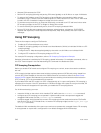
Enabling the FCoE Transit Feature
The following sections describe how to enable FCoE transit.
NOTE: FCoE transit is disabled by default. To enable this feature, you must follow the Configure FIP
Snooping.
As soon as you enable the FCoE transit feature on a switch-bridge, existing VLAN-specific and FIP
snooping configurations are applied. The FCoE database is populated when the switch connects to a
converged network adapter (CNA) or FCF port and compatible DCB configurations are synchronized. By
default, all FCoE and FIP frames are dropped unless specifically permitted by existing FIP snooping-
generated ACLs. You can reconfigure any of the FIP snooping settings.
If you disable FCoE transit, FIP and FCoE traffic are handled as normal Ethernet frames and no FIP
snooping ACLs are generated. The VLAN-specific and FIP snooping configuration is disabled and stored
until you re-enable FCoE transit and the configurations are re-applied.
Enable FIP Snooping on VLANs
You can enable FIP snooping globally on a switch on all VLANs or on a specified VLAN.
When you enable FIP snooping on VLANs:
• FIP frames are allowed to pass through the switch on the enabled VLANs and are processed to
generate FIP snooping ACLs.
• FCoE traffic is allowed on VLANs only after a successful virtual-link initialization (fabric login FLOGI)
between an ENode and an FCF. All other FCoE traffic is dropped.
• You must configure at least one interface for FCF (FCoE Forwarder) mode on a FIP snooping-enabled
VLAN. You can configure multiple FCF trusted interfaces in a VLAN.
• A maximum of eight VLANS are supported for FIP snooping on the switch. When enabled globally, FIP
snooping processes FIP packets in traffic only from the first eight incoming VLANs. When enabled on
a per-VLAN basis, FIP snooping is supported on up to eight VLANs.
Configure the FC-MAP Value
You can configure the FC-MAP value to be applied globally by the switch on all or individual FCoE VLANs
to authorize FCoE traffic.
The configured FC-MAP value is used to check the FC-MAP value for the MAC address assigned to
ENodes in incoming FCoE frames. If the FC-MAP value does not match, FCoE frames are dropped. A
session between an ENode and an FCF is established by the switch-bridge only when the FC-MAP value
on the FCF matches the FC-MAP value on the FIP snooping bridge.
Configure a Port for a Bridge-to-Bridge Link
If a switch port is connected to another FIP snooping bridge, configure the FCoE-Trusted Port mode for
bridge-bridge links.
Initially, all FCoE traffic is blocked. Only FIP frames with the ALL_FCF_MAC and ALL_ENODE_MAC values
in their headers are allowed to pass. After the switch learns the MAC address of a connected FCF, it
allows FIP frames destined to or received from the FCF MAC address.
FCoE traffic is allowed on the port only after the switch learns the FC-MAP value associated with the
specified FCF MAC address and verifies that it matches the configured FC-MAP value for the FCoE VLAN.
350
FCoE Transit


















